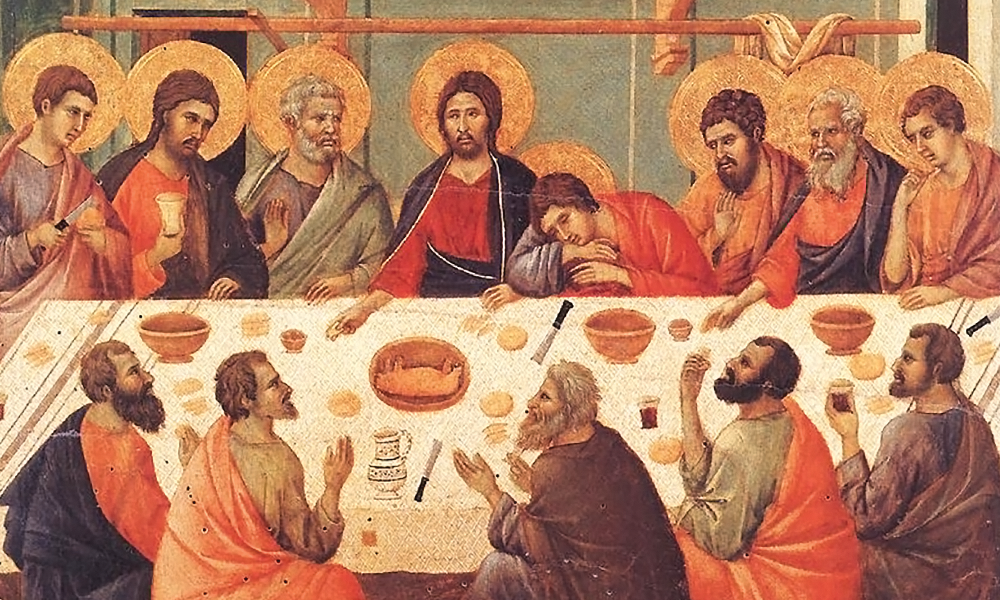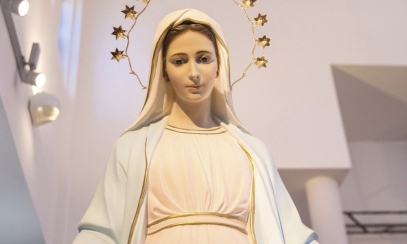
Bride and Branch
The Catholic tradition of contemplative prayer
The Catholic tradition of contemplative prayer
How would you do if you stopped reading this article and simply placed yourself in Jesus’ presence for 60 seconds? Give it a try right now, perhaps imagining your head resting on the Lord’s chest or shoulder, just like St. John experienced at the Last Supper. Don’t expend energy talking at Jesus during this sacred minute; just abide in him quietly, like a branch receiving life from the Divine Vine. (Jn. 15:1-17)
What was your experience like? For some people, this kind of prayer – Christian contemplation – comes rather easily, but for many of us it’s a challenge. And if it is a challenge, we can talk to God about it and ask the Holy Spirit to help us.
What is Christian contemplation?
The Catechism of the Catholic Church connects its definition of Christian contemplation with the story of St. John Vianney’s encounter with a poor villager. St. Vianney is known as “the Curé [parish priest] of Ars,” the small French village where he ministered for over four decades and which quickly became a major pilgrimage site largely because of the saint’s dedication to the Sacrament of Reconciliation.
“Contemplation is a gaze of faith, fixed on Jesus. ‘I look at him and he looks at me’: this is what a certain peasant of Ars in the time of his holy curé [St. John Vianney] used to say while praying before the tabernacle.” (CCC 2715)
Contemplative prayer in the Christian tradition has often been compared to an elderly wife and husband who are often happy to just be in each other’s presence without having to say much.
“Slow down, you move too fast…”
Simon and Garfunkel popularized this phrase in their 1966 hit, “The 59th Street Bridge Song.” The wisdom in this lyric reminds me of an incident in the life of Mother Teresa. On one of her visits to the United States, she was picked up at the airport by a local priest. As they drove, the priest explained all of the things he was involved with in his diocese. The saint listened patiently. Then at one point, he said, “Mother, I am so busy I barely have time to pray.” To which she gently replied, “Father, if you are too busy to pray, then you are too busy.”
The frenetic pace of life in the western world, along with the fragmenting impact of modern media and smartphones, makes it hard to stop and accept God’s invitation to “Be still and know that I am God!” (Ps. 46:11) Towards the end of the 20th century, the Catholic poet Denise Levertov described modern man as trapped in a nightmarish, fragmenting carnival:
Like a child
at a barbaric fairgrounds –
noise, lights, the violent odors –
Adam fragments himself. The whirling rides!
Fragmented Adam stares.
God's hands
unseen, the whirling rides
dazzle, the lights blind him. Fragmented,
he is not present to himself. God
suffers the void that is his absence.
- From “On a Theme by Thomas Merton”
Christian contemplative prayer is an antidote to our spiritual fragmentation. We experience God’s presence and he experiences ours. This quiet, receptive approach to prayer allows us to be regathered, and to attain a simplicity of spirit that makes us like God – God who is absolutely simple. In philosophy and Catholic theology, “simple” means “no parts”…and therefore, “no fragmentation.” In this sense, the Church affirms that God is eminently simple, and this is one reason God-centered contemplative prayer brings us such a divine sense of peace.
It is important to note a key difference between Christian contemplation and practices from Eastern religions like Zen meditation, rooted in Buddhism. Eastern meditation often asks its practitioners to empty their minds of all thoughts in order to have a sense of being “one with the universe.” But Christian contemplative prayer insists that we focus on the Triune God – and especially on Christ who, as Scripture says, is “the icon of the invisible God.” (Col. 1:15)
It is a true gift to have communion with the three divine persons who created the universe rather than settle for a vague sense of “being one” with the planets and stars they created. Creation cannot offer us love and salvation. Redemption is only through Christ the Lord, “through whom all things were made,” as the Nicene Creed proclaims.
The call to be bridal
Christian contemplative prayer means making time to be purely receptive before the Lord. Quiet receptivity in prayer before the Lord allows us to put into practice what Jesus tells us in the Gospel of John. As mentioned, he calls his disciples to be like a branch grafted into him, the Vine. If we do as Jesus asks, he promises that we will then bear fruit in our Christian journey.
However, there is another image from Scripture that connects with our call to be radically receptive before the Lord, including through the practice of contemplative prayer: the Church as bride. St. Paul speaks of how the relationship between a husband and wife reflects the mystery of Christ, the Bridegroom and the Church, his bride. (Eph. 5:32)
Pope St. John Paul II beautifully expounds on this theme:
“In the context of the ‘great mystery’ of Christ and of the Church, all are called to respond – as a bride – with the gift of their lives to the inexpressible gift of the love of Christ, who alone, as the Redeemer of the world, is the Church’s Bridegroom. This concerns everyone in the Church, women as well as men.” (“On the Dignity and Vocation of Women,” 27)
Receiving the loving gaze of the Lord
As the peasant explained to St. Vianney, in contemplative prayer, we gaze at the Lord and he gazes at us. And the fact that the peasant prayed this way in front of Jesus’ Eucharistic presence in a tabernacle is significant for us as we move through this time of the Eucharistic Revival in the United States.
So let us make more time to simply receive the Lord’s loving gaze in our daily lives. As Pope Francis reminds us: “Jesus' gaze always lifts us up. It is a look that always lifts us up, and never leaves you in your place, never lets us down, never humiliates. It invites you to get up – a look that brings you to grow, to move forward, that encourages you.”
Being bride or being branch – that is, making time for intentional receptivity in our lives of prayer – does not lock us into ourselves; rather, having received light and grace from the Lord in contemplating him and his “look of love,” we can then bear fruit by making ourselves a gift for others. It is no wonder that a young Father Josef Ratzinger insisted that for our salvation, we are “meant to rely on receiving”:
“The primacy of receiving is not intended to condemn man to passivity; it doesn’t mean that man can now sit idle…. On the contrary, it alone makes it possible to do things of this world in a spirit of responsibility, yet at the same time in an uncramped, cheerful, free way, and to put them at the service of redemptive love.”
Dr. Dan Osborn is the Diocesan Theologian and Coordinator of Permanent Diaconate Formation & Ministry for the Diocese of Saginaw.



